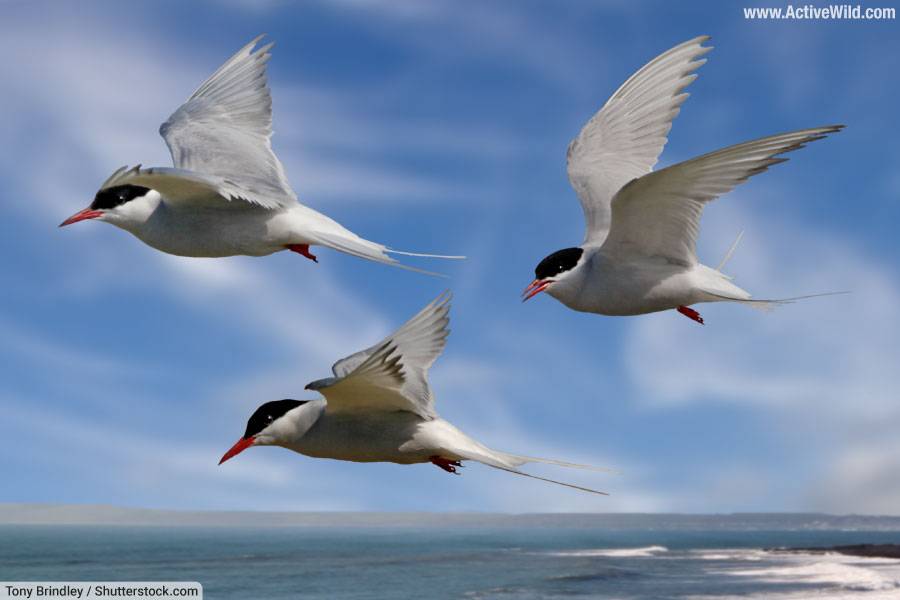
A list of cool animals, with pictures and interesting facts. What are the world’s coolest species? Read on to find out…
What Are The Coolest Animals?
A cool animal might have special abilities (aye-aye, cheetah, immortal jellyfish); it might look cool (maned wolf, narwhal, proboscis monkey); it might be particularly badass (electric eel, honey badger, polar bear); or it might have an amazing lifestyle (arctic tern, wandering albatross, emperor penguin).
In compiling this list, we’ve only included living animals; would the Komodo dragon really have made the grade if Tyrannosaurus rex had been in the running? Snow leopards are cool and all, but are they as cool as American cave lions? (Actually, yes, not many animals are as cool as snow leopards!)
If you want to see cool prehistoric animals, then check out these pages:
Sadly, many of the cool animals on this list are endangered. We’ve included the IUCN Red List conservation status (checked 09/22/23) of each species on the list.
This is our list of cool animals… what species are in yours? Let us know the animals you agree with (and any cool animals we’ve missed out) in the comments section at the bottom of the page!
Cool Animals List
Arctic Tern

- Scientific Name: Sterna paradisaea
- Family: Laridae
- Length: 0.33–0.39 meters; 1–1.3 feet
- Where Found: Arctic and subarctic regions; migrates to Antarctic waters
- IUCN Conservation Status: Least Concern
The Arctic Tern is renowned for its extraordinary migration, traveling from its Arctic breeding grounds to the Antarctic and back each year, covering approximately 44,000 miles. This amazing bird sees two summers every year! It is a sleek, medium-sized tern with a deeply forked tail and long, slender wings.
Discover More with Active Wild
You can see more Arctic animals on this page: Arctic Animals
Discover different types of birds on this page: Types of Birds
Axolotl
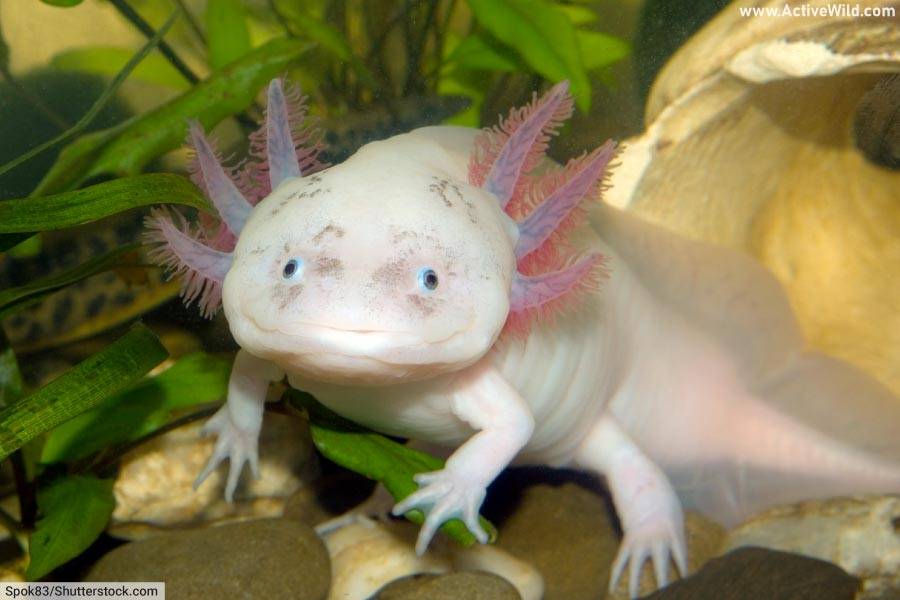
- Scientific Name: Ambystoma mexicanum
- Family: Ambystomatidae
- Length: 0.15–0.45 meters; 0.5–1.5 feet
- Where Found: Endemic to the remnants of Xochimilco Lake in Mexico City, Mexico
- IUCN Conservation Status: Critically Endangered
The Axolotl is a fascinating salamander known for its unique ability to regenerate lost body parts, including the heart and brain. It is a neotenic salamander, meaning it retains its aquatic juvenile characteristics throughout its life. (Unlike other amphibians, it doesn’t undergo metamorphosis and leave the water as an adult.)
Discover More with Active Wild
You can find out more about this animal on this page: Axolotl Facts
You can find out more about amphibians on this page: Amphibians – The Ultimate Guide
You can discover more amphibians on this page: Amphibians Examples
Aye-Aye
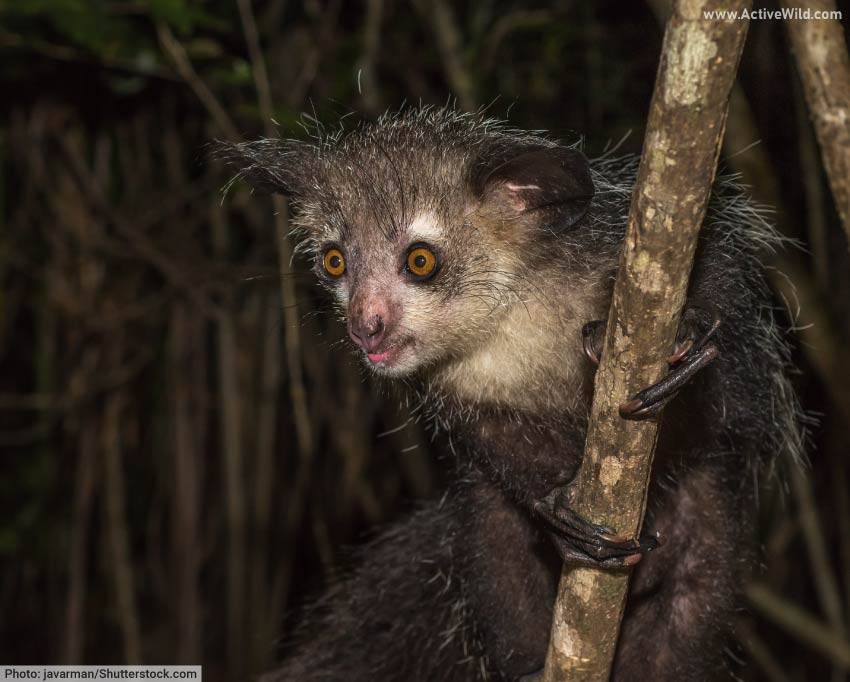
- Scientific Name: Daubentonia madagascariensis
- Family: Daubentoniidae
- Length: 0.36–0.44 meters; 1.2–1.4 feet (body length)
- Where Found: Madagascar
- IUCN Conservation Status: Endangered
The Aye-Aye is a nocturnal lemur known for its peculiar middle finger, which it uses to tap on trees to find grubs and to extract them. (It can tell by the sound of the taps if there’s food under the bark.)
The aye-aye is the largest nocturnal primate and has bushy tails and big, sensitive ears. Like all lemurs, this cool animal is found only on the African island country of Madagascar.
Discover More with Active Wild
You can find out more about this animal on this page: Aye-Aye Facts
You can find out more about primates on this page: Primates – Ultimate Guide
Black Mamba
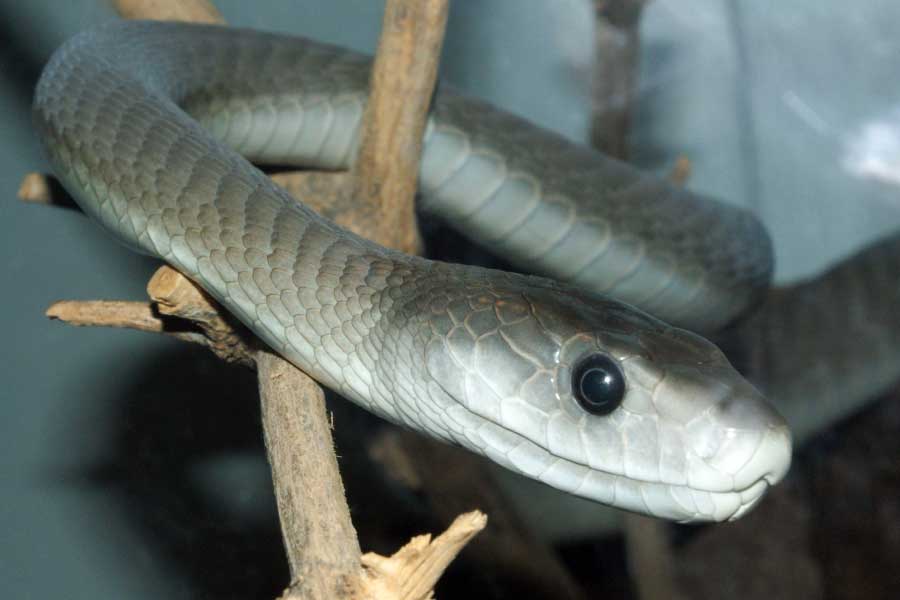
- Scientific Name: Dendroaspis polylepis
- Family: Elapidae
- Length: Up to 4.5 meters; 14.8 feet
- Where Found: Sub-Saharan Africa
- IUCN Conservation Status: Least Concern
The Black Mamba is one of the fastest and most venomous snakes in the world, capable of reaching speeds of up to 20 km/h (12.4 mph). It is actually olive-brown in color but gets its name from the inky black interior of its mouth.
Discover More with Active Wild
You can find out more about this animal on this page: Black Mamba Facts
You can find out more about snakes on this page: Snake Facts
Discover different types of snakes on this page: Types of Snakes
Bullet Ant
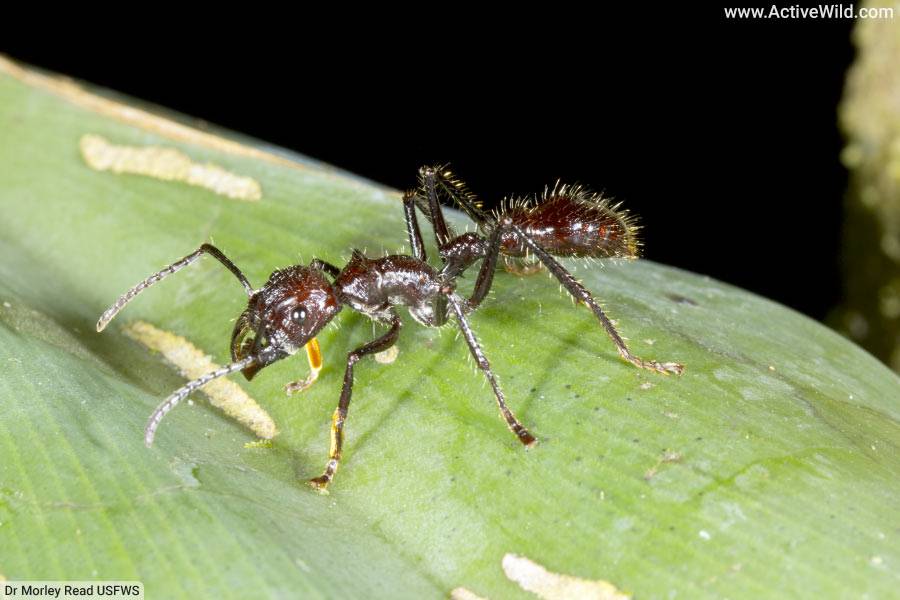
- Scientific Name: Paraponera clavata
- Family: Formicidae
- Length: Approximately 0.03 meters; 1.2 inches
- Where Found: Rainforests in Central and South America
- IUCN Conservation Status: Not Assessed
The Bullet Ant is named for its extremely painful sting, which is said to be equivalent to being shot. This rainforest species has the most painful sting of any insect, according to the Schmidt Sting Pain Index.
Discover More with Active Wild
You can find out more about this animal on this page: Bullet Ant Facts
You can see more rainforest animals on this page: Rainforest Animals List with Pictures & Facts
Chambered Nautilus
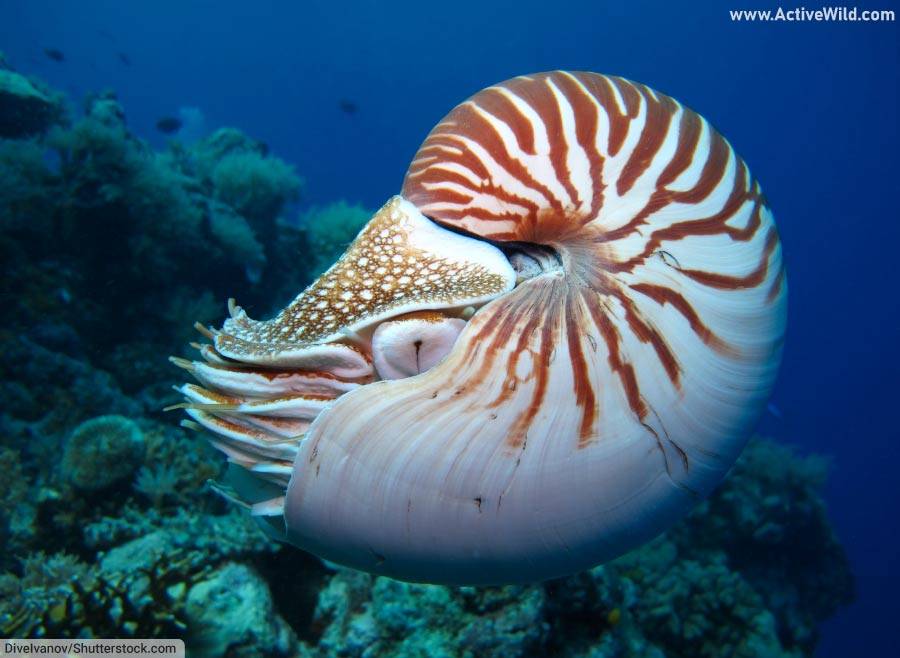
- Scientific Name: Nautilus pompilius
- Family: Nautilidae
- Length: Up to 0.25 meters; 0.82 feet (shell diameter)
- Where Found: Indo-Pacific Ocean
- IUCN Conservation Status: Not Evaluated
The Chambered Nautilus is a marine mollusk with a spiral shell divided into chambers. It moves by jet propulsion, expelling water from its body.
Nautiluses are among the oldest species on the planet, having survived relatively unchanged for millions of years. These cool animals were around with the earliest dinosaurs!
Discover More with Active Wild
Discover different types of mollusks on this page: Mollusks Examples
You can see more ocean animals on this page: Ocean Animals List with Pictures & Facts
Chameleon
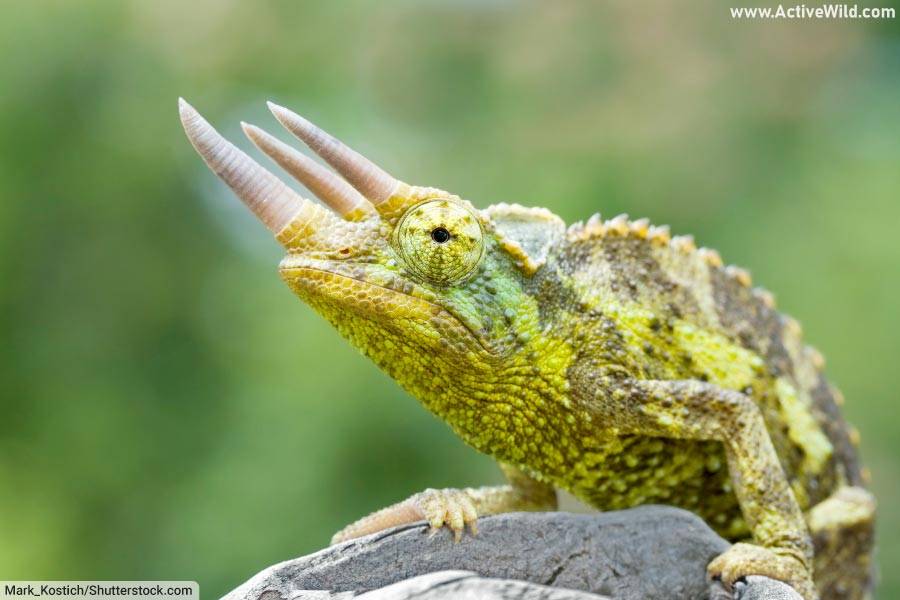
- Scientific Name: (numerous species)
- Family: Chamaeleonidae
- Length: Varies widely by species, from 0.03 to 0.68 meters; 1 inch to 2.2 feet
- Where Found: Mainly in Africa and Madagascar, with some species in southern Europe, Asia, and the Middle East
- IUCN Conservation Status: Varies by species
Chameleons are well-known for their ability to change color, which serves as a form of communication and camouflage. If that weren’t cool enough, they also have highly modified, rapidly extrudable tongues for capturing prey, turret-like eyes that move independently, and feet with toes that face both forwards and backwards (this feature is known as Zygodactyly).
Discover More with Active Wild
Discover different types of reptiles on this page: Types of Reptiles
Discover different types of lizards on this page: Types of Lizards
Cheetah

- Scientific Name: Acinonyx jubatus
- Family: Felidae
- Length: 1.1–1.5 meters; 3.6–4.9 feet (body length)
- Where Found: Sub-Saharan Africa, parts of Iran
- IUCN Conservation Status: Vulnerable
The Cheetah is the fastest land animal, capable of reaching speeds up to 58–64 mph in just a few seconds. This cool cat has a slender body, a small head, and long legs, adapted for speed. Its spotted coat helps it blend into its surroundings while hunting.
Discover More with Active Wild
You can find out more about this animal on this page: Cheetah Facts
You can see more African animals on this page: African Animals
You can see EVERY species of cat on this page: Wild Cats Species List with Pictures and Facts
Electric Eel
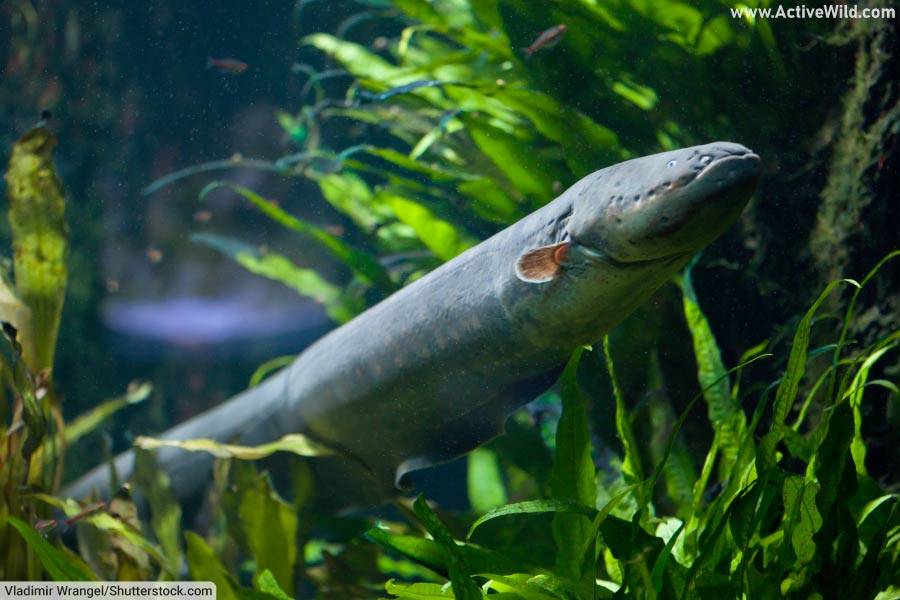
- Scientific Name: Electrophorus electricus
- Family: Gymnotidae
- Length: Up to 2.5 meters; 8.2 feet
- Where Found: Amazon and Orinoco River basins in South America
- IUCN Conservation Status: Least Concern
The Electric Eel is capable of generating electric shocks of up to 600 volts to locate prey, communicate, and defend itself. Despite its name, it is not a true eel but a knifefish.
Other cool fish able to produce electricity include the torpedo rays, after which the underwater weapon was named.
Discover More with Active Wild
You can find out more about this animal on this page: Electric Eel Facts
You can see more South American animals on this page: South American Animals
Emperor Penguin

- Scientific Name: Aptenodytes forsteri
- Family: Spheniscidae
- Length: 1.1–1.3 meters; 3.6–4.3 feet
- Where Found: Antarctica
- IUCN Conservation Status: Near Threatened
The Emperor Penguin is the tallest and heaviest of all penguin species. It is well-adapted to living in extreme cold and can dive to depths of over 500 meters (1,640 feet) to catch its prey.
During the freezing Antarctic winter, male emperor penguins stand in groups, protecting their eggs by holding them on top of their feet, away from the ice. They stand like this for over two months, making them–quite literally–some of the coolest animals on the planet!
Discover More with Active Wild
You can find out more about this animal on this page: Emperor Penguin Facts
You can see every species of penguin on this page: Types of Penguins
You can see more Antarctic animals on this page: Antarctic Animals
Flying Squirrel
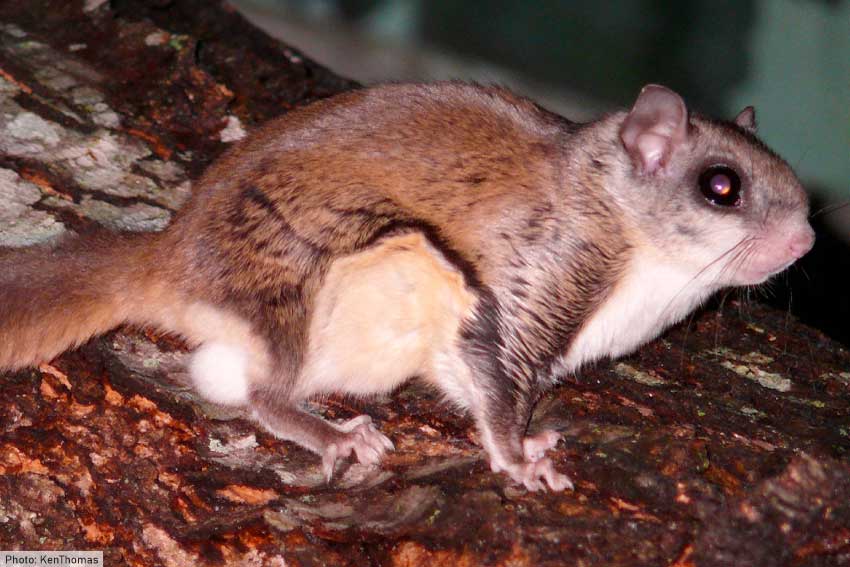
- Scientific Name: Various, in the tribe Pteromyini
- Family: Sciuridae
- Length: Varies by species; approximately 0.25–0.6 meters; 0.82–2 feet including tail
- Where Found: North America, Asia, (Northern) Europe
- IUCN Conservation Status: Varies by species
Flying squirrels don’t actually fly but instead glide between trees using a patagium, a membrane stretching from wrist to ankle. These rodents are nocturnal and have large eyes, adapted for night vision.
There are around 50 species of flying squirrels, found in forests in North America, Asia, and northern Europe.
Discover More with Active Wild
You can find out more about rodents on this page: Rodents – The Ultimate Guide
Fossa
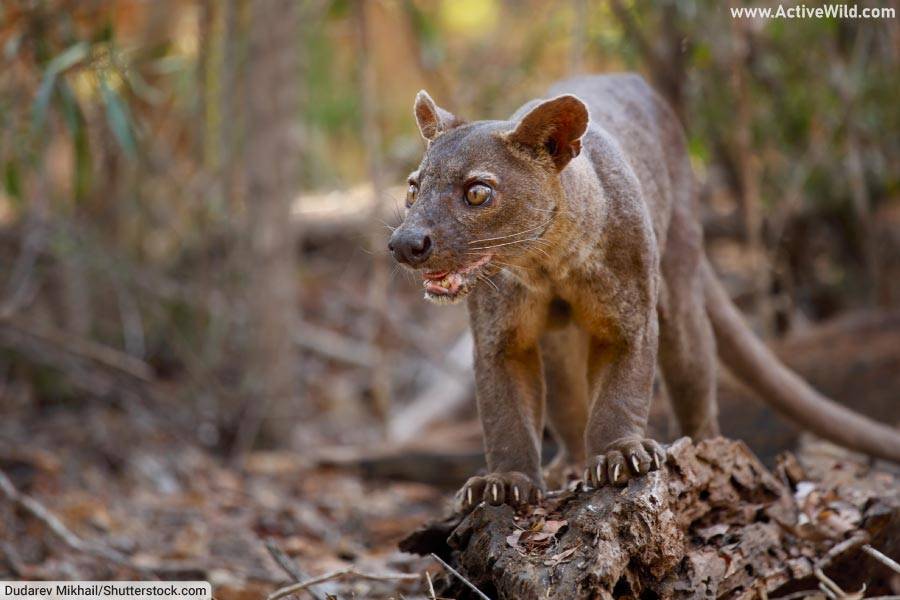
- Scientific Name: Cryptoprocta ferox
- Family: Eupleridae
- Length: 0.7–0.8 meters; 2.3–2.6 feet (body length)
- Where Found: Madagascar
- IUCN Conservation Status: Vulnerable
The Fossa is the largest mammalian carnivore on the African island country Madagascar. It has a slender body, resembling a cat, and preys mainly on lemurs. It is a solitary and territorial animal, known for its agility in trees.
Discover More with Active Wild
You can see more African animals on this page: African Animals
Galápagos Tortoise
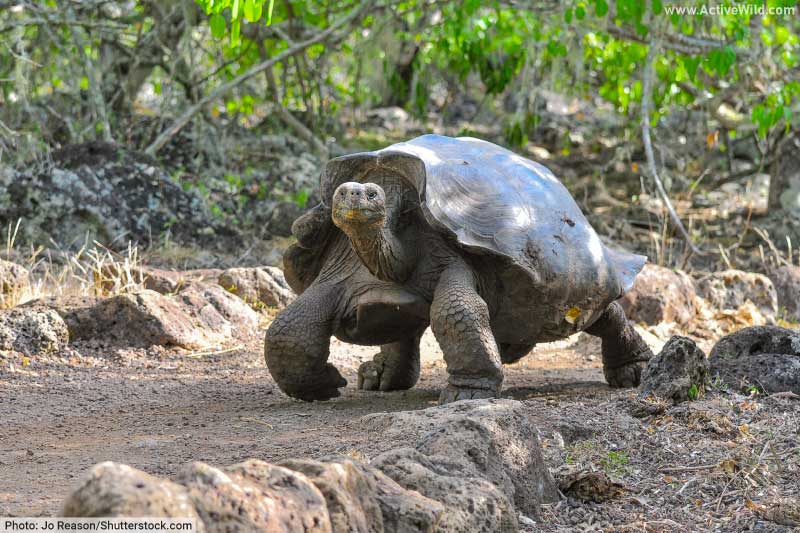
- Scientific Name: Chelonoidis nigra
- Family: Testudinidae
- Length: 1.22 meters; 4 feet (shell length)
- Where Found: Galápagos Islands
- IUCN Conservation Status: Unassessed as single species – several subspecies Endangered
The Galápagos Tortoise is the largest living species of tortoise, reaching weights in excess of 400 kg / 881.85 lb. It is known for its extremely slow metabolism and long lifespan, which can exceed 100 years in the wild.
Charles Darwin’s study of these tortoises, which are found only on the Galápagos Islands, played a role in his theory of evolution by natural selection.
Discover More with Active Wild
You can find out more about reptiles on this page: Reptiles – The Ultimate Guide
Discover different types of reptiles on this page: Types of Reptiles
Gharial
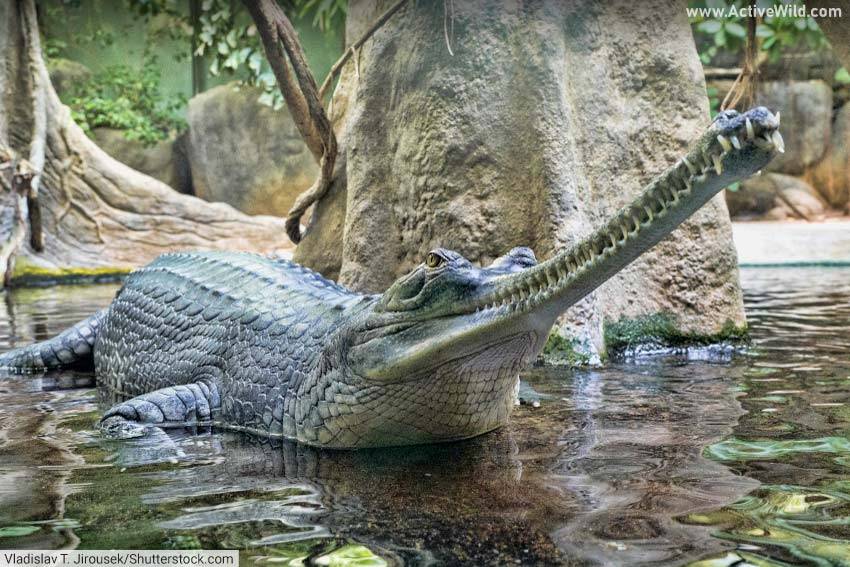
- Scientific Name: Gavialis gangeticus
- Family: Gavialidae
- Length: 3.5–6 meters; 11–20 feet
- Where Found: Northern Indian subcontinent
- IUCN Conservation Status: Critically Endangered
The Gharial has a distinctive, elongated snout adapted for catching fish. It is one of the longest of all living crocodilians and is primarily aquatic, rarely leaving the water except to bask or nest.
Discover More with Active Wild
You can find out more about this animal on this page: Gharial Facts
You can find out more about reptiles on this page: Reptiles – The Ultimate Guide
Discover different types of reptiles on this page: Types of Reptiles
Golden Poison Frog
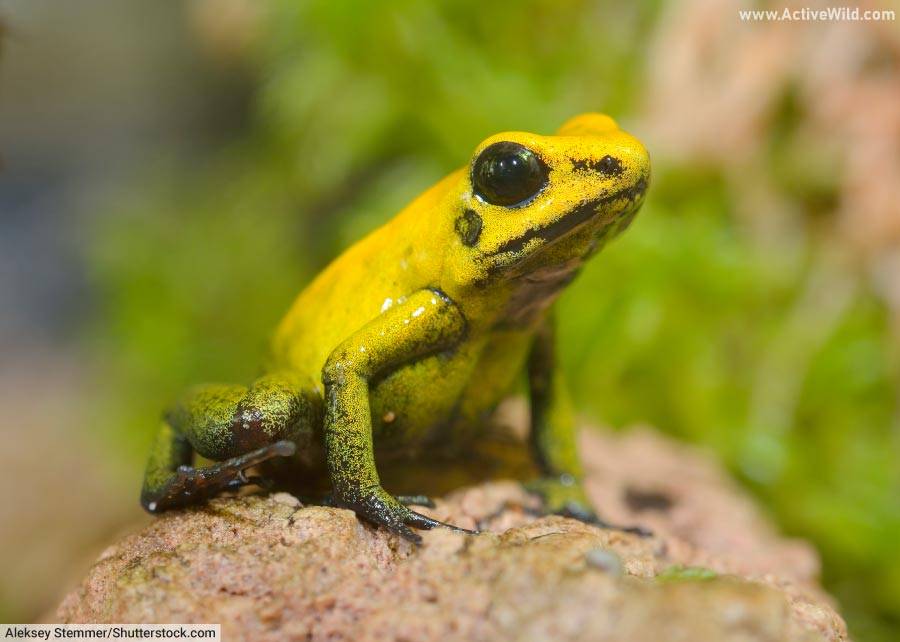
- Scientific Name: Phyllobates terribilis
- Family: Dendrobatidae
- Length: 0.055 meters; 2.2 inches
- Where Found: Western Colombia
- IUCN Conservation Status: Endangered
This brightly colored amphibian is one of the most toxic animals in the world; the skin of one individual can contain enough toxins to kill several adult humans. Indigenous people have used its poison to tip their blowdarts for hunting.
Discover More with Active Wild
You can find out more about this animal on this page: Golden Poison Frog Facts
You can discover more amphibians on this page: Amphibians Examples
You can see more rainforest animals on this page: Rainforest Animals List with Pictures & Facts
Indri

- Scientific Name: Indri indri
- Family: Indriidae
- Length: 0.64–0.7 meters; 2.1–2.3 feet
- Where Found: Madagascar
- IUCN Conservation Status: Critically Endangered
The Indri, also known as the babakoto, is among the largest living lemurs. It has a distinctive black and white coat and lacks a tail, unlike other lemurs. This cool animal is known for its loud, haunting, song-like vocalizations that can travel for more than 2 km through the forest.
The Indri primarily feeds on leaves but also consumes fruits, seeds, and flowers. It is arboreal and well-adapted to life in the trees, capable of making leaps of up to 10 meters (33 feet) from tree to tree. The Indri forms monogamous pairs which maintain small family territories. Sadly, due to habitat destruction and hunting, it faces a high risk of extinction in the wild.
Discover More with Active Wild
You can find out more about primates on this page: Primates – Ultimate Guide
Great White Shark

- Scientific Name: Carcharodon carcharias
- Family: Lamnidae
- Length: 4–6 meters; 13–20 feet
- Where Found: Coastal waters in all major oceans
- IUCN Conservation Status: Vulnerable
The Great White Shark is one of the most powerful predators in the ocean, known for its size, speed, and sharp, serrated teeth. It has a diverse diet, including fish, seals, and carrion. This cool ocean animal had a bad reputation even before it featured in the movie Jaws.
Discover More with Active Wild
You can find out more about this animal on this page: Great White Shark Facts
Find out more about sharks on this page: Shark Facts
Discover different types of sharks on this page: Types of Sharks
Hoatzin
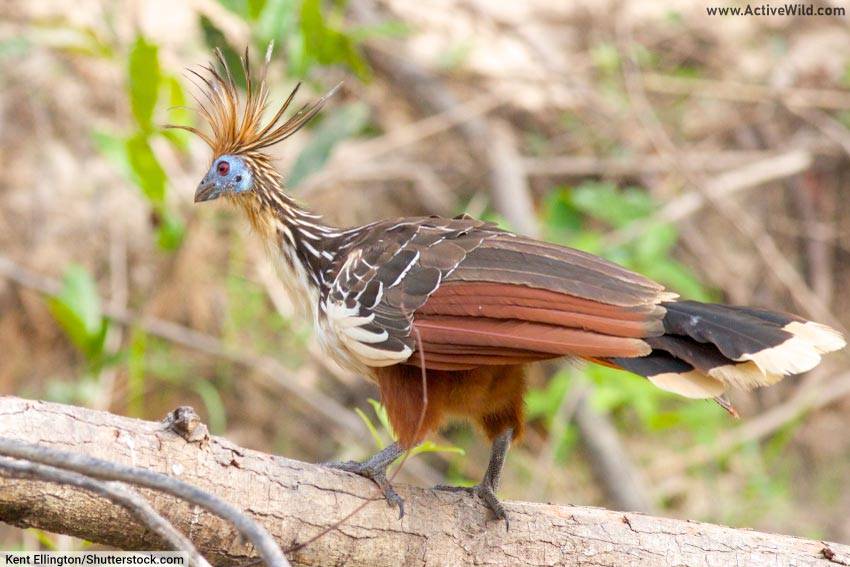
- Scientific Name: Opisthocomus hoazin
- Family: Opisthocomidae
- Length: 0.65 meters; 2.1 feet
- Where Found: Swamps, riverine forest, and mangroves in the Amazon and Orinoco Delta in South America
- IUCN Conservation Status: Least Concern
The Hoatzin is a unique bird distinguished by its digestive system, which ferments plant material, creating a manure-like smell, earning it the nickname “stinkbird.” It has blue facial skin, maroon eyes, and a crest of feathers on its head.
Discover More with Active Wild
You can find out more about birds on this page: Birds – The Ultimate Guide
Discover different types of birds on this page: Types of Birds
Honey Badger

- Scientific Name: Mellivora capensis
- Family: Mustelidae
- Length: 0.9 meters; 2.95 feet
- Where Found: Sub-Saharan Africa, the Middle East, and the Indian subcontinent
- IUCN Conservation Status: Near Threatened
Known for its legendary tenacity and strength, the Honey Badger, like all badgers, is a member of the weasel family, Mustelidae. The species has a diverse diet, which includes the larvae of honeybees, hence its name. It has thick, loose skin, which allows it to turn and bite when grabbed, and is resistant to bee stings and snake venom.
The honey badger is even known to take out black mambas – one of the world’s most fearsome snakes (and another species featured in this list of cool animals).
Discover More with Active Wild
You can see more African animals on this page: African Animals
Immortal Jellyfish
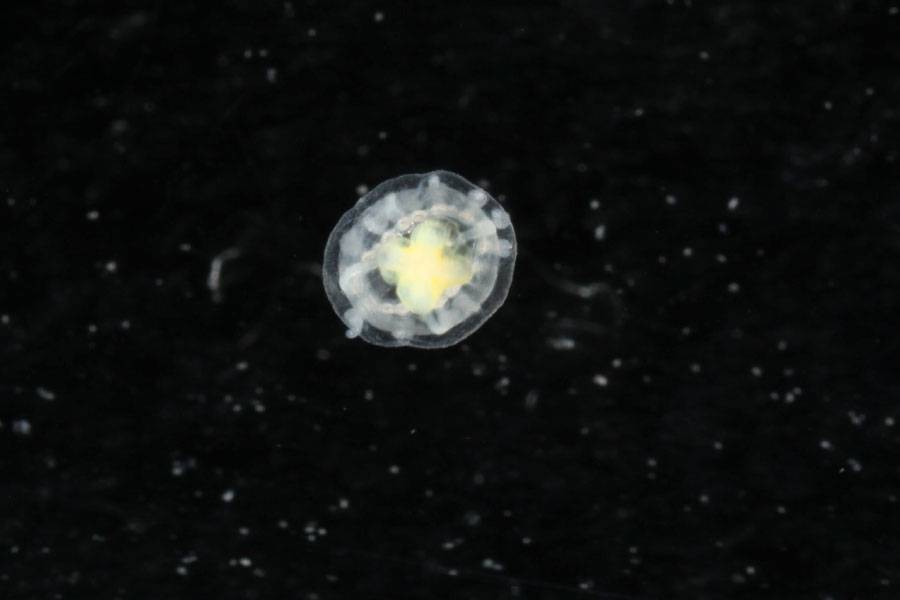
- Scientific Name: Turritopsis dohrnii
- Family: Oceaniidae
- Length: 0.005 meters; 0.2 inches (bell diameter)
- Where Found: Mediterranean Sea, waters of Japan
- IUCN Conservation Status: Not Assessed
The Immortal Jellyfish has the unique ability to revert its cells back to their earliest form and start its life cycle anew, theoretically allowing it to live indefinitely under the right conditions, hence its common name.
Discover More with Active Wild
You can see more ocean animals on this page: Ocean Animals List with Pictures & Facts
You can see more weird animals on this page: Weird Animals List with Pictures
Komodo Dragon
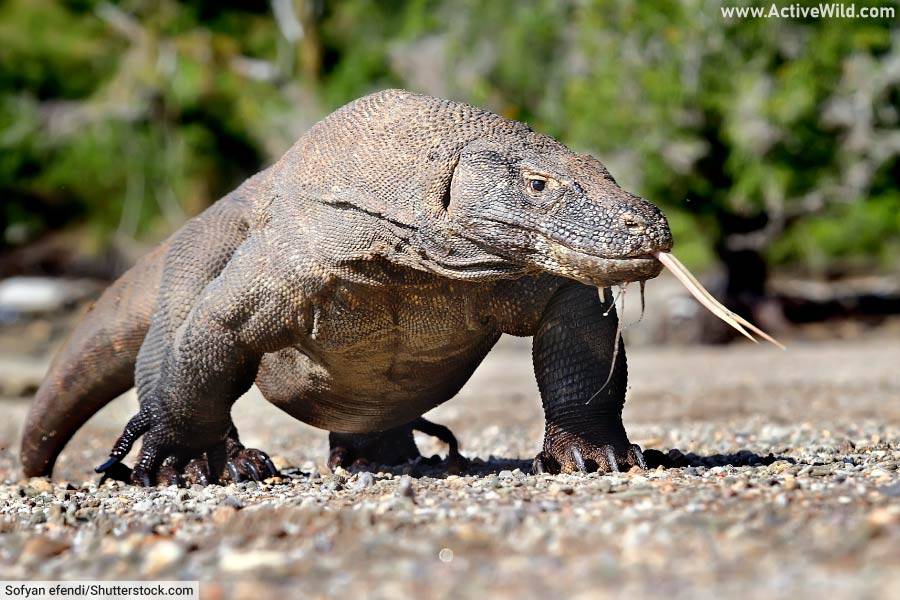
- Scientific Name: Varanus komodoensis
- Family: Varanidae
- Length: Up to 3 meters; 9.8 feet
- Where Found: Indonesian islands of Komodo, Rinca, Flores, Gili Motang, and Padar
- IUCN Conservation Status: Endangered
The Komodo Dragon is the largest living species of lizard. Named after one of the Indonesian islands on which it is found, it has a robust body, powerful limbs, and sharp claws.
Scientists only recently discovered that the Komodo dragon has venom glands loaded with toxins that lower blood pressure, cause massive bleeding, induce shock, and prevent clotting in its prey.
Discover More with Active Wild
You can find out more about this animal on this page: Komodo Dragon Facts
You can see more Asian animals on this page: Asian Animals
Leaf Sheep
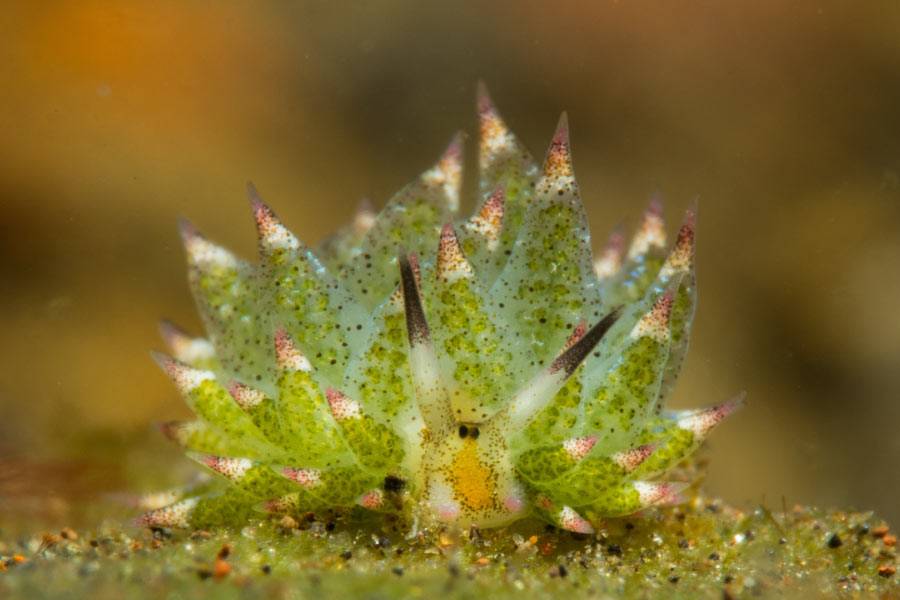
- Scientific Name: Costasiella kuroshimae
- Family: Limapontiidae
- Length: 0.005 meters; 0.2 inches
- Where Found: Japan, Philippines, and Northern Australia
- IUCN Conservation Status: Not Assessed
The Leaf Sheep is a type of sacoglossan sea slug that can photosynthesize, like a plant, by incorporating chloroplasts from the algae it eats into its cells, a process known as kleptoplasty.
The rounded body and prominent, ear-like antennae of the leaf sheep give it a vaguely sheep-like appearance, hence its common name.
Discover More with Active Wild
You can see more ocean animals on this page: Ocean Animals List with Pictures & Facts
Discover more weird sea animals on this page: Weird Sea Creatures
Leafcutter Ants
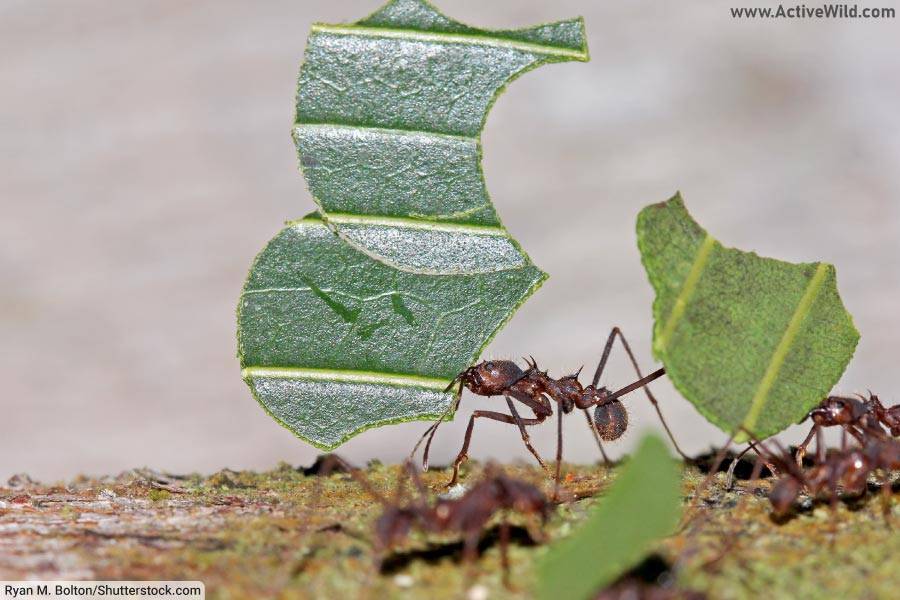
- Scientific Name: Atta spp.
- Family: Formicidae
- Length: 0.006–0.012 meters; 0.25–0.5 inches
- Where Found: Americas, primarily in South and Central America
- IUCN Conservation Status: Various
Leafcutter Ants are known for cutting leaves and carrying them back to their nests. They don’t eat the leaves themselves, but instead use them to cultivate a fungus, which serves as their primary food source.
Discover More with Active Wild
You can find out more about this animal on this page: Leafcutter Ant Facts
You can find out more about insects on this page: Insects – The Ultimate Guide
Leatherback Sea Turtle
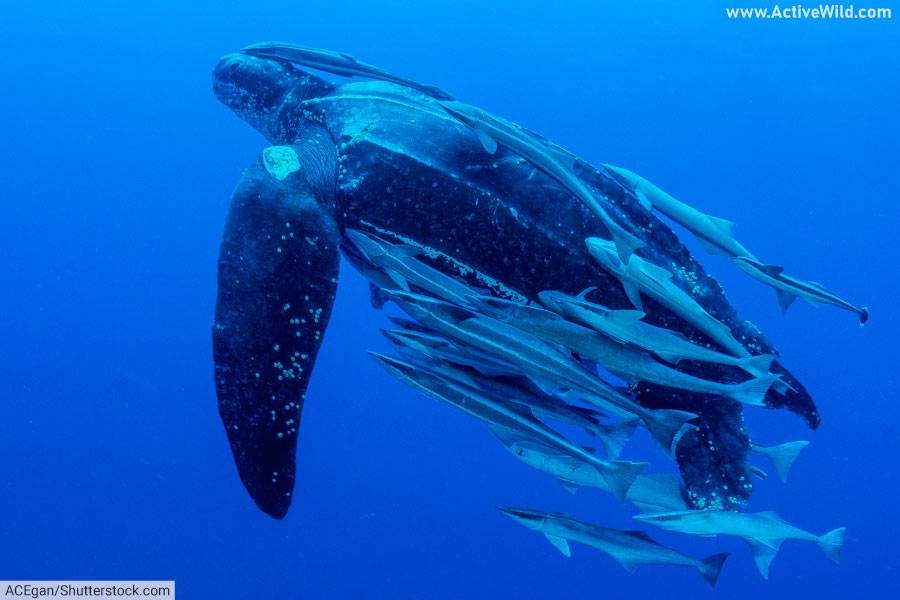
- Scientific Name: Dermochelys coriacea
- Family: Dermochelyidae
- Length: Up to 3 meters; 9.8 feet
- Where Found: Oceans worldwide
- IUCN Conservation Status: Vulnerable
The Leatherback is the largest of all living turtles and is distinguished by its leathery shell. It primarily feeds on jellyfish and can regulate its body temperature, allowing it to inhabit colder waters compared to other sea turtles. In other words, this “cool” animal is one of the only reptiles able to keep its body at a higher temperature than its surroundings.
Discover More with Active Wild
You can find out more about this animal on this page: Leatherback Sea Turtle Facts
Discover different types of turtles on this page: Types of Turtles
Lungfish
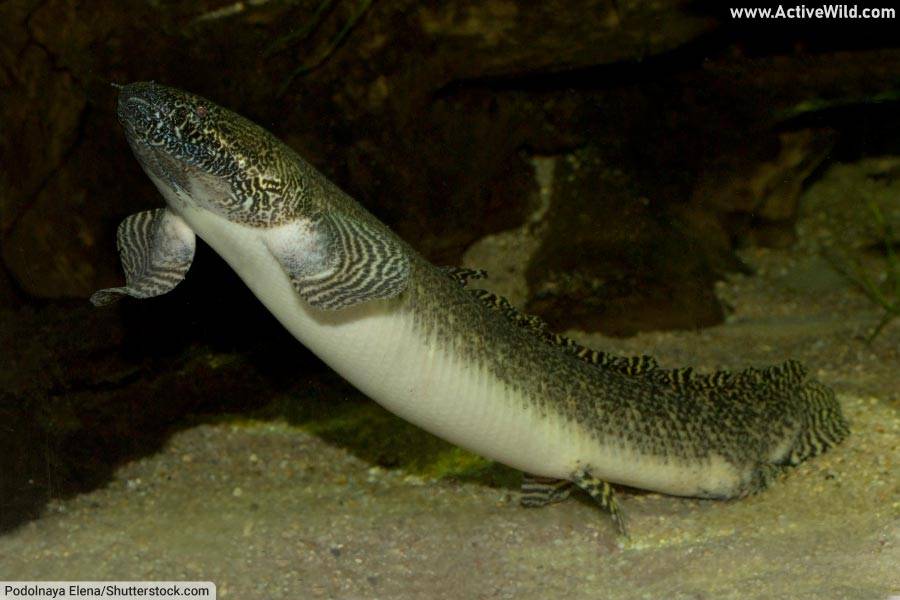
- Scientific Name: (Various species in the class Dipnoi)
- Family: Various, including Protopteridae and Lepidosirenidae
- Length: Varies by species; up to 2 meters; 6.6 feet in some species
- Where Found: Africa, South America, and Australia
- IUCN Conservation Status: Varies by species
Lungfish have both gills and lungs, allowing them to breathe air and survive in environments with low oxygen levels. Some species can aestivate in a mucous cocoon during dry seasons, breathing air until the water returns.
These amazing fish are thought resemble the fish-like ancestors of all mammals, reptiles, amphibians and birds. Somewhere in your family tree is an animal that resembled a lungfish!
Discover More with Active Wild
You can find out more about fish on this page: Fish – The Ultimate Guide
Discover different types of fish on this page: Types of Fish
Maned Wolf
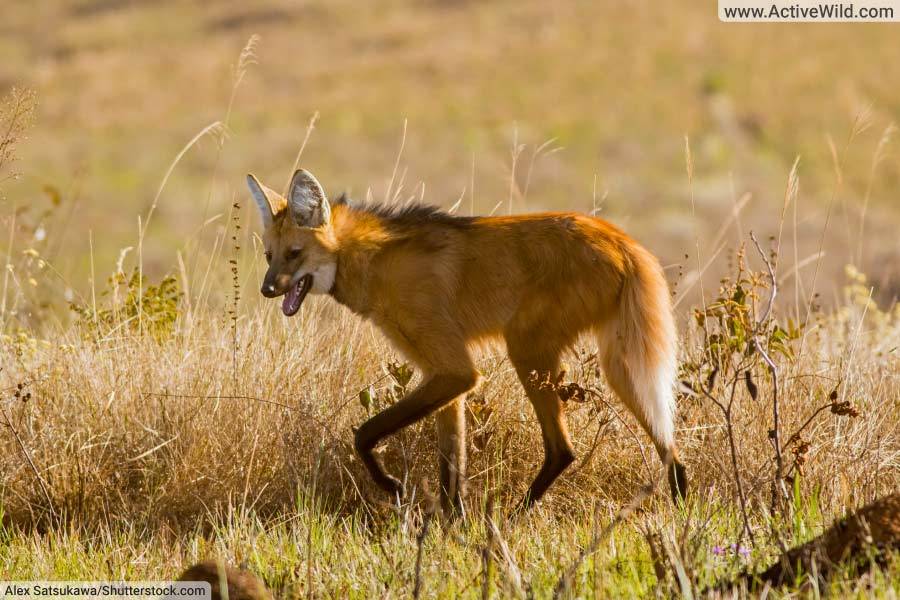
- Scientific Name: Chrysocyon brachyurus
- Family: Canidae
- Length: 1.25 meters; 4.1 feet
- Where Found: South America
- IUCN Conservation Status: Near Threatened
The Maned Wolf is the largest canid of South America. (A canid is a member of the dog family, Canidae.) It has long, slender legs believed to adapt to the tall grasslands of its native habitat. It is solitary and omnivorous, feeding on small animals and plant matter, particularly the fruit of the lobeira plant.
Discover More with Active Wild
You can see more South American animals on this page: South American Animals
You can find out more about dogs on this page: Dog Facts
Mata Mata Turtle
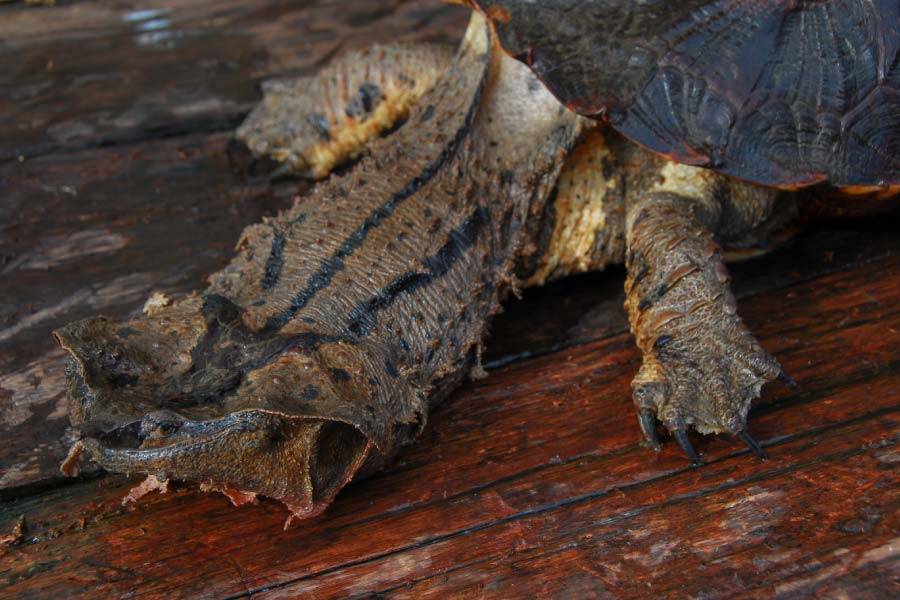
- Scientific Name: Chelus fimbriata
- Family: Chelidae
- Length: 0.45 meters; 1.5 feet (shell length)
- Where Found: Amazon and Orinoco basins in South America
- IUCN Conservation Status: Not Evaluated
The Mata Mata Turtle has a large, triangular, flattened head with many tubercles and flaps of skin, and a horn on its long snout. It is well camouflaged and remains motionless in the water, waiting for prey, and catches it by creating a low-pressure vacuum that sucks the prey into its mouth.
Discover More with Active Wild
Discover different types of turtles on this page: Types of Turtles
You can see more South American animals on this page: South American Animals
Mimic Octopus
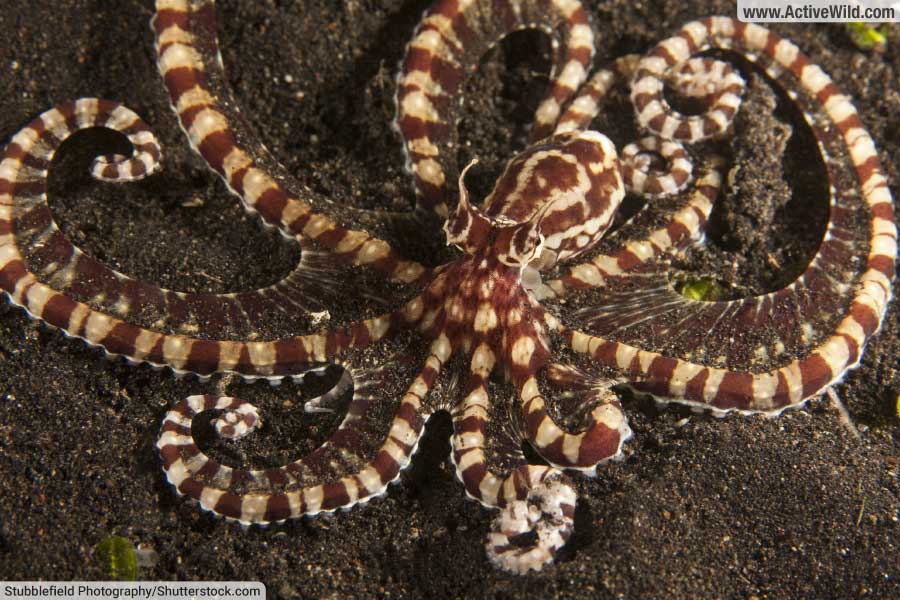
- Scientific Name: Thaumoctopus mimicus
- Family: Octopodidae
- Length: 0.6 meters; 2 feet (arm span)
- Where Found: Indo-Pacific Ocean
- IUCN Conservation Status: Least Concern
The Mimic Octopus is renowned for its ability to impersonate other marine animals such as flatfish, lionfish, and sea snakes, adopting their forms and behaviors to avoid predators.
You can see the mimic octopus in action in the video below:
Discover More with Active Wild
You can see more ocean animals on this page: Ocean Animals List with Pictures & Facts
Discover more weird sea animals on this page: Weird Sea Creatures
Naked Mole Rat
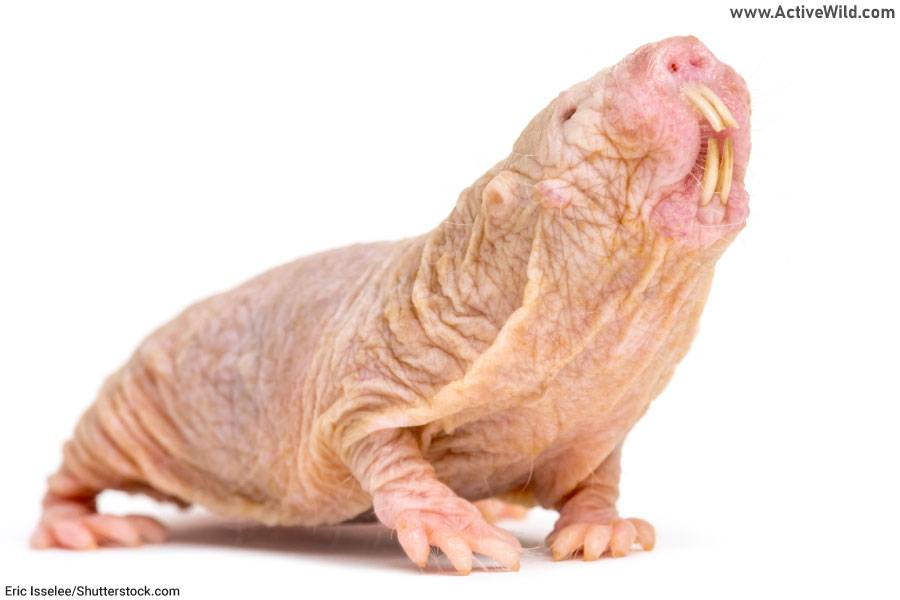
- Scientific Name: Heterocephalus glaber
- Family: Bathyergidae
- Length: 0.03–0.04 meters; 1–1.4 inches
- Where Found: East Africa
- IUCN Conservation Status: Least Concern
The Naked Mole Rat is a subterranean rodent that lacks fur and has a long, hairless, and tubular body. It has a highly organized, eusocial structure similar to that of some insects. It has a high resistance to cancer and can live up to 30 years, exceptionally long for a rodent.
It may not look pretty (we’ve included the naked mole rat in our list of ugly animals, too) but this strange-looking rodent is certainly unusual.
Discover More with Active Wild
You can see more African animals on this page: African Animals
You can find out more about rodents on this page: Rodents – The Ultimate Guide
Narwhal
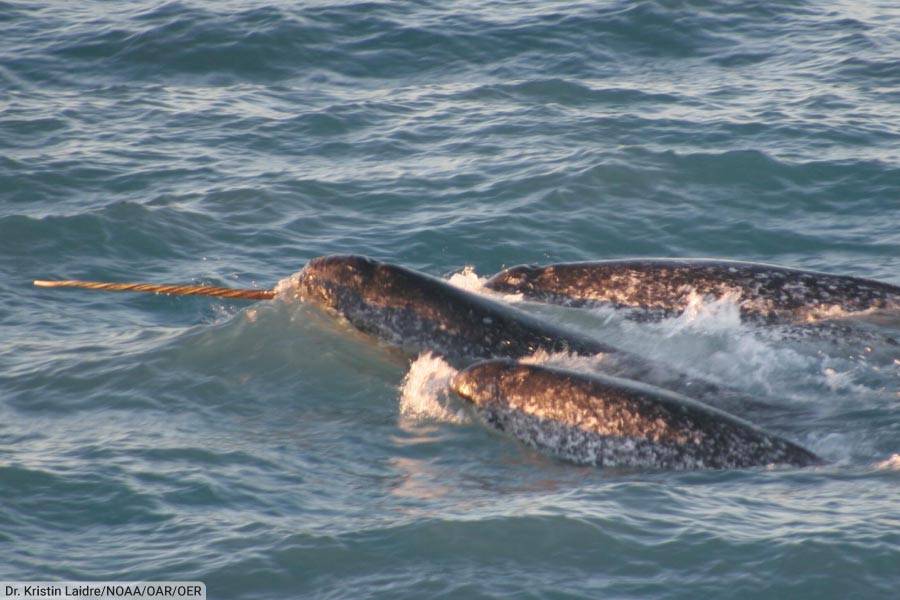
- Scientific Name: Monodon monoceros
- Family: Monodontidae
- Length: Up to 5.5 meters; 18 feet (males, including tusk)
- Where Found: Arctic and Subarctic waters
- IUCN Conservation Status: Least Concern
The Narwhal is a medium-sized toothed whale, known for the long, spiral tusk developed from a protruding canine tooth in males. It was once thought that narwhal tusks were the horns of the legendary unicorn.
The purpose of the tusk is believed to be related to mating displays and intraspecific rivalry. This narwhal primarily feeds on squid, fish, and shrimp.
Discover More with Active Wild
You can find out more about this animal on this page: Narwhal Facts
Discover all living species of whales on this page: All Whale Species with Pictures & Facts
Okapi
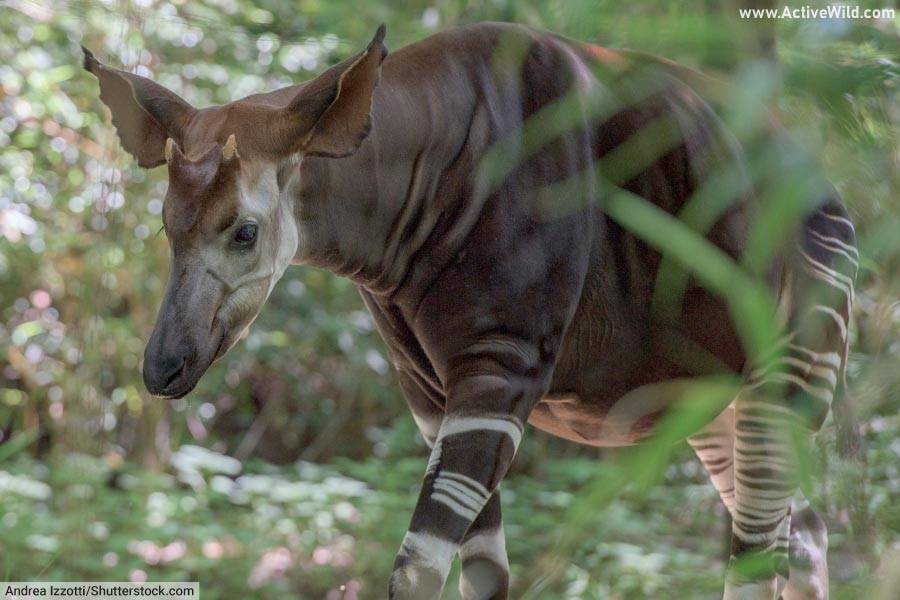
- Scientific Name: Okapia johnstoni
- Family: Giraffidae
- Length: 2.5 meters; 8.2 feet
- Where Found: Democratic Republic of the Congo (Central Africa)
- IUCN Conservation Status: Endangered
The Okapi has a horse-like body with legs resembling a zebra’s. Surprisingly, this African forest animal’s closest living relative is the giraffe. It has large, flexible ears and a long tongue, enabling it to strip leaves and buds from trees.
Okapis are solitary and have scent glands on their feet to mark their territory.
Discover More with Active Wild
You can find out more about this animal on this page: Okapi Facts
You can see more forest animals on this page: Forest Animals
Ornate Flying Snake
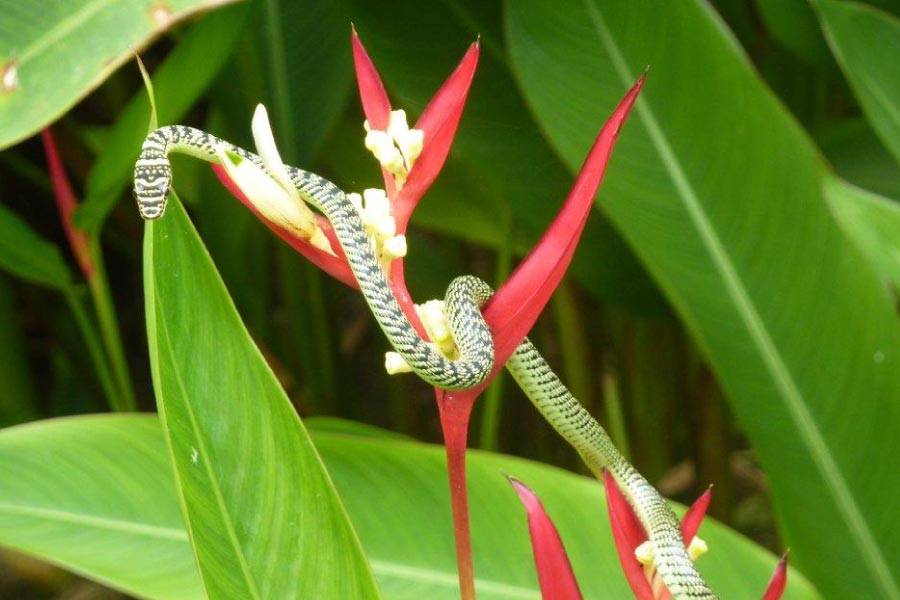
- Scientific Name: Chrysopelea ornata
- Family: Colubridae
- Length: 1–1.2 meters; 3.3–4 feet
- Where Found: Southeast Asia, including Thailand, Malaysia, Indonesia, and Singapore
- IUCN Conservation Status: Least Concern
The ornate flying snake is one of several snakes that can glide through the air by flattening their bodies, allowing them to quickly move from tree to tree.
Despite being venomous, the ornate flying snake is considered harmless to humans due to its small venom glands and non-aggressive nature.
Discover More with Active Wild
You can find out more about reptiles on this page: Reptiles – The Ultimate Guide
Discover different types of reptiles on this page: Types of Reptiles
Pangolin
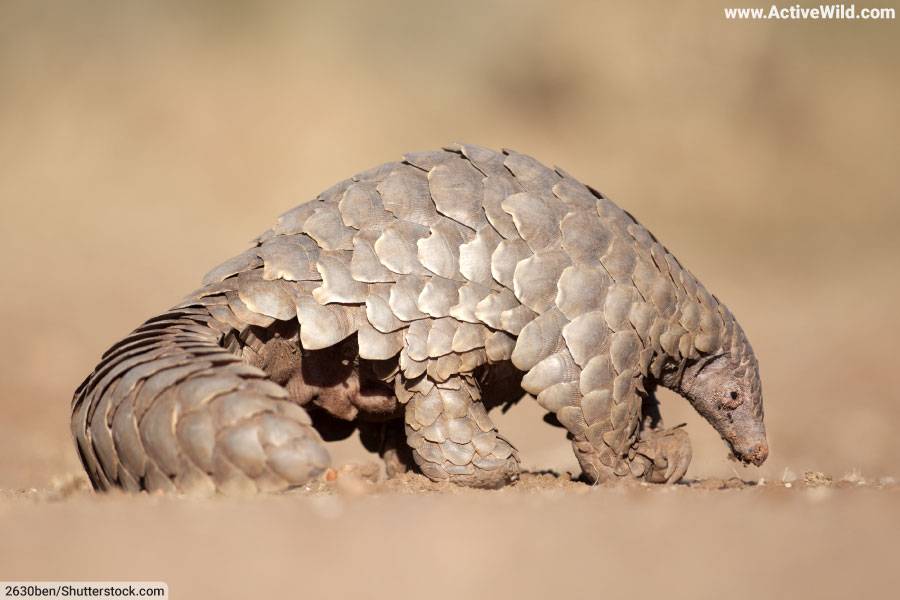
- Family: Manidae
- Length: 0.3–1.8 meters; 1–5.9 feet (varies by species)
- Where Found: Africa and Asia
- IUCN Conservation Status: Varies by species; ranges from Vulnerable to Critically Endangered
Pangolins are the only mammals covered in scales, which they use for protection by rolling into a ball when threatened. They primarily feed on ants and termites using their long tongues. Pangolins are heavily poached for their scales and meat, making them one of the most trafficked animals in the world.
Discover More with Active Wild
You can find out more about mammals on this page: Mammals – The Ultimate Guide
Discover different types of mammals on this page: Types of Mammals
Peregrine Falcon
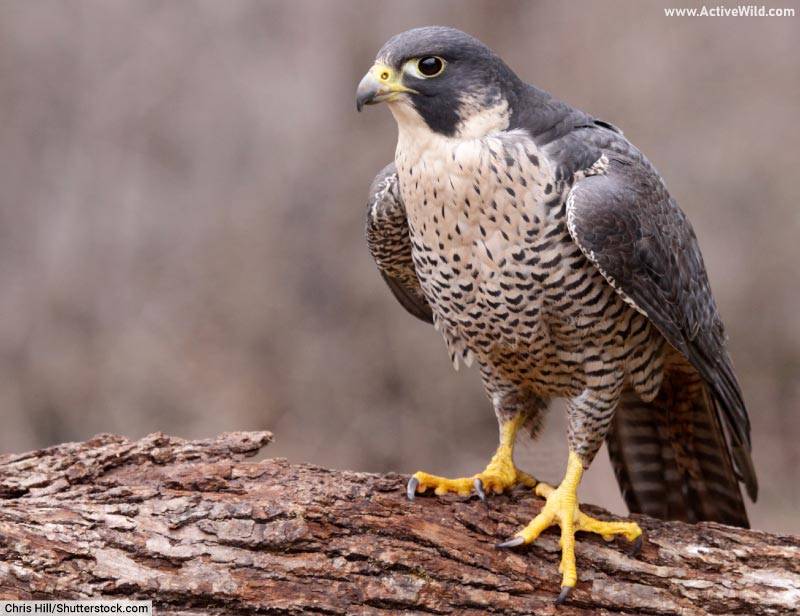
- Scientific Name: Falco peregrinus
- Family: Falconidae
- Length: 0.34–0.58 meters; 1.1–1.9 feet
- Where Found: Worldwide
- IUCN Conservation Status: Least Concern
The Peregrine Falcon is the fastest living animal, able to reach over 240 mph during its characteristic hunting stoop (high-speed dive).
The bird of prey has a cosmopolitan distribution and primarily preys on other birds. It has made a significant recovery since the ban of DDT pesticide, which had severely impacted its populations.
Discover More with Active Wild
You can find out more about birds on this page: Birds – The Ultimate Guide
Discover different types of birds on this page: Types of Birds
Platypus

- Scientific Name: Ornithorhynchus anatinus
- Family: Ornithorhynchidae
- Length: 0.5 meters; 1.6 feet (male); 0.43 meters; 1.4 feet (female)
- Where Found: Eastern Australia including Tasmania
- IUCN Conservation Status: Near Threatened
The Platypus is one of the few (five, in fact) mammals that lay eggs. It has a distinctive duck-like bill, webbed feet, and males have a venomous spur on the hind foot capable of delivering a painful venom. It is a semi-aquatic mammal that feeds on invertebrates.
Discover More with Active Wild
You can find out more about this animal on this page: Platypus Facts
You can see more Australian animals on this page: Australian Animals
You can see more weird animals on this page: Weird Animals List with Pictures
Polar Bear
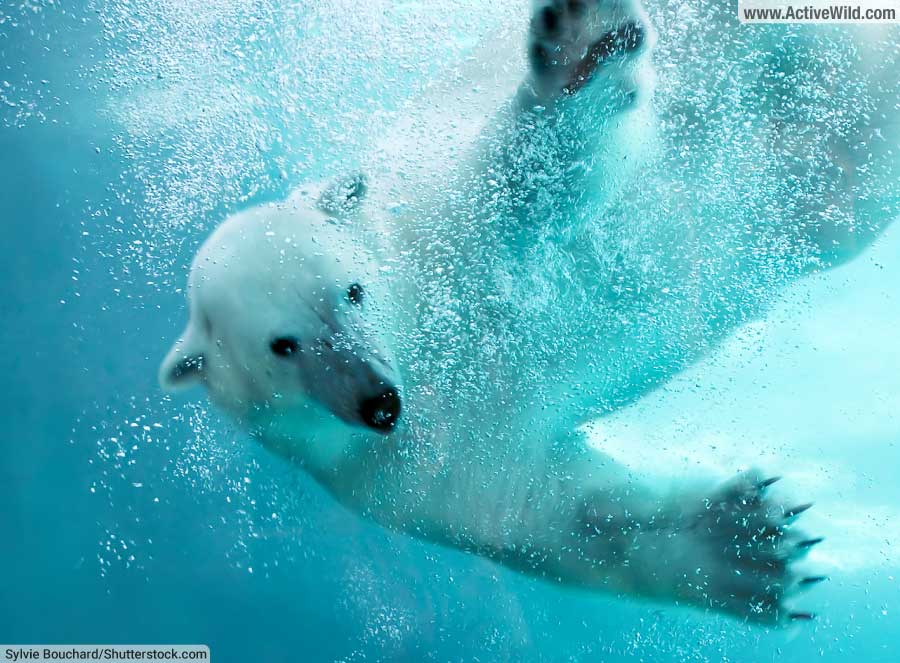
- Scientific Name: Ursus maritimus
- Family: Ursidae
- Length: 2.4–3 meters; 7.9–9.8 feet
- Where Found: Arctic Circle
- IUCN Conservation Status: Vulnerable
As an iconic animal of the Arctic, the Polar Bear is both literally and figuratively one of the world’s coolest animals.
The Polar Bear is the largest land carnivore, being larger on average than the closely-related brown bear (the Kodiak bear, a brown bear subspecies, may be larger, but other types of brown bear are smaller).
Adapted for life in the Arctic, the polar bear has white fur for camouflage in the snow, and huge paws for walking on ice and swimming. It primarily preys on seals.
Polar bears are marine mammals, and they spend much of their time at sea, with their primary habitat being the sea ice.
Discover More with Active Wild
You can find out more about this animal on this page: Polar Bear Facts
You can see more Arctic animals on this page: Arctic Animals
Discover all eight bear species on this page: Types of Bears with Pictures & Facts
Portuguese Man O’ War
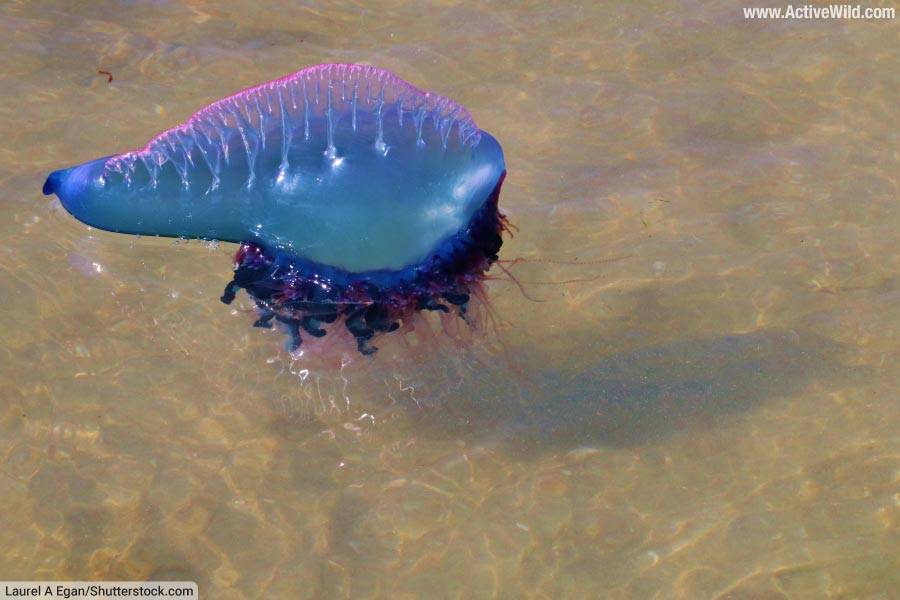
- Scientific Name: Physalia physalis
- Family: Physaliidae
- Length: Tentacles can extend up to 30 meters; 98 feet
- Where Found: Warm water oceans
- IUCN Conservation Status: Not Evaluated
Often mistaken for a jellyfish, the Portuguese Man O’ War is actually a siphonophore, a colony of individual polyps working together. In other words, a single Portuguese Man O’ War is actually a group of animals of the same species but with specialized bodies.
These potentially dangerous animals have a gas-filled bladder that sits above the water and acts as a sail, and long, venomous tentacles that can deliver painful stings.
Discover More with Active Wild
You can find out more about this animal on this page: Portuguese Man O’ War Facts
You can see more ocean animals on this page: Ocean Animals List with Pictures & Facts
Proboscis Monkey
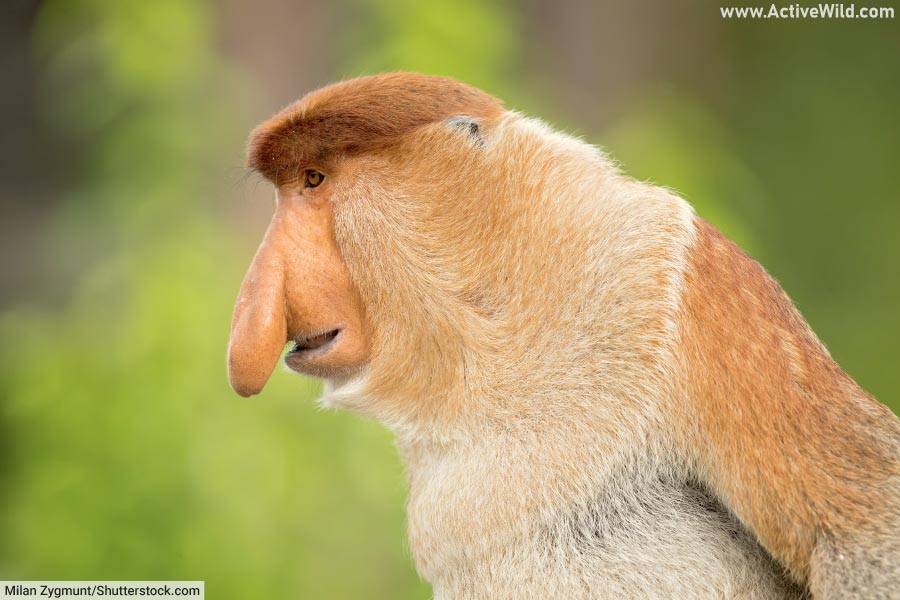
- Scientific Name: Nasalis larvatus
- Family: Cercopithecidae
- Length: 0.66–0.76 meters; 2.17–2.49 feet
- Where Found: Island of Borneo (Southeast Asia)
- IUCN Conservation Status: Endangered
Recognizable by its large nose, the Proboscis Monkey is an arboreal species endemic to Borneo’s mangrove, swamp, and riverine forests. Males have significantly larger noses than females, and it is believed that the size of the nose is related to attracting mates.
We’ve included the proboscis monkey in this list of cool animals due to its unique appearance. It’s also in our list of ugly animals, which you can see here: Ugly Animals List with Pictures And Facts
Discover More with Active Wild
You can find out more about this animal on this page: Proboscis Monkey Facts
You can see more ugly animals on this page: Ugly Animals List with Pictures & Facts
Quokka
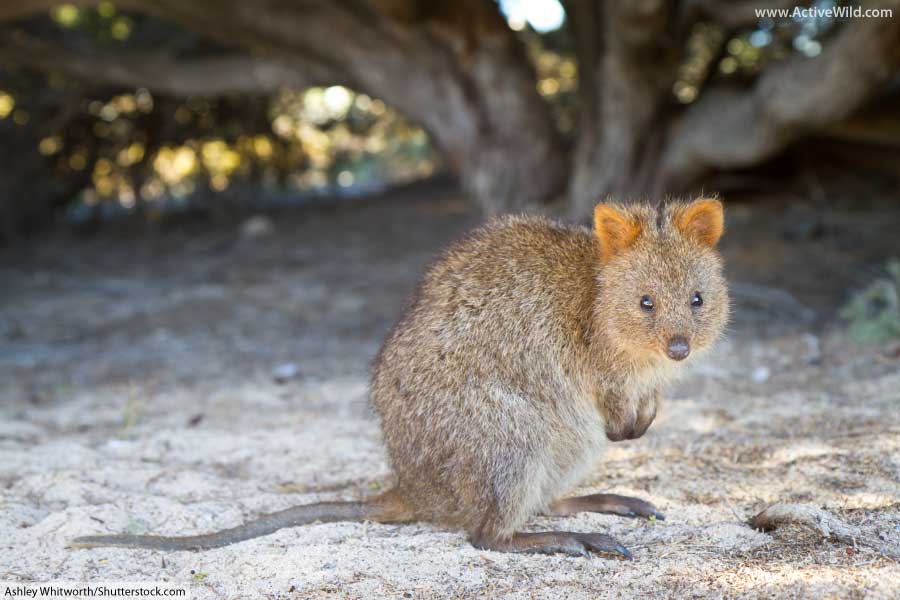
- Scientific Name: Setonix brachyurus
- Family: Macropodidae
- Length: 0.4–0.54 meters; 1.3–1.8 feet
- Where Found: Small islands off the coast of Western Australia
- IUCN Conservation Status: Vulnerable
Often referred to as “the world’s happiest animal,” due to its seemingly cheerful expression, the Quokka is a small, herbivorous marsupial. It has adapted to its environment by being mainly nocturnal and obtaining most of its water from its plant-based diet.
Discover More with Active Wild
You can see more Australian animals on this page: Australian Animals
You can see more marsupials on this page: Types of Marsupials
Rhesus Macaque
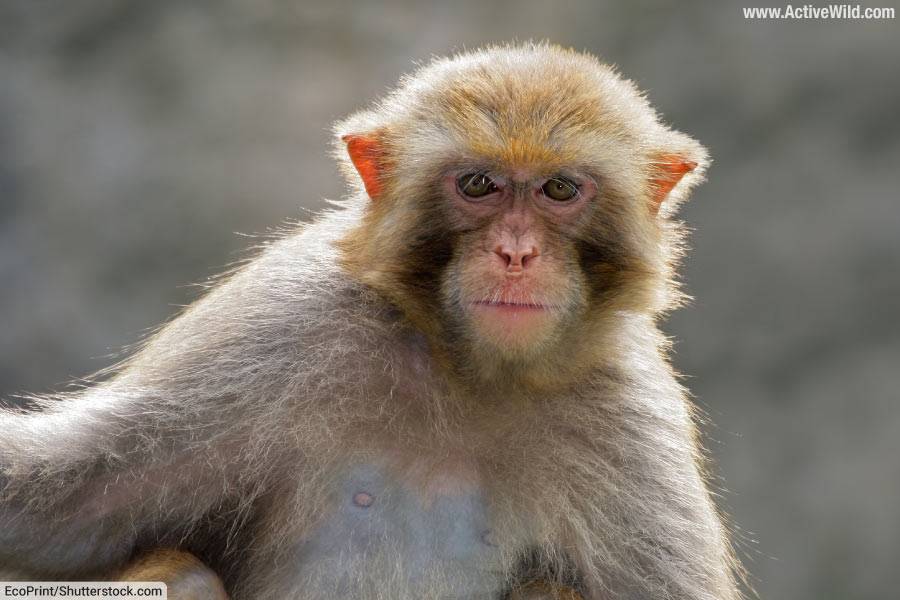
- Scientific Name: Macaca mulatta
- Family: Cercopithecidae
- Length: 0.47–0.65 meters; 1.5–2.1 feet
- Where Found: South, Central, and Southeast Asia
- IUCN Conservation Status: Least Concern
The Rhesus Macaque is one of the best-known species of Old World monkeys and is known for its wide range of vocalizations. It has a highly diverse diet and is adaptable to multiple habitats but prefers mixed wooded areas close to water. It is of significant importance in medical and biological research due to its closeness to humans, anatomically and genetically.
What’s particularly cool about the rhesus monkey is that it was not only the first monkey, but also the first mammal to go to space. (Sadly, the monkey in question, Albert II, died due to a parachute failure on his return to Earth.)
Discover More with Active Wild
You can find out more about this animal on this page: Rhesus Macaque Facts
You can find out more about primates on this page: Primates – Ultimate Guide
Sailfish
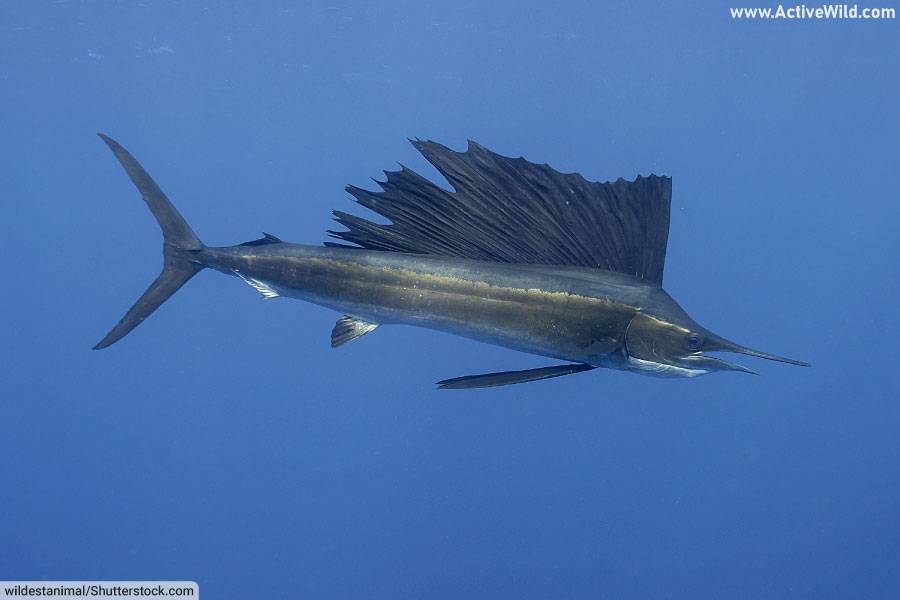
- Scientific Name: Istiophorus platypterus
- Family: Istiophoridae
- Length: 3.05 meters; 10 feet
- Where Found: Atlantic and Indo-Pacific Oceans
- IUCN Conservation Status: Vulnerable
Known as the fastest fish in the ocean, the Sailfish can reach speeds up to 68 mph. It has a distinctive sail-like dorsal fin and a long, slender body. It is a highly prized game fish due to its speed and agility.
Discover More with Active Wild
You can find out more about fish on this page: Fish – The Ultimate Guide
Discover different types of fish on this page: Types of Fish
Shoebill
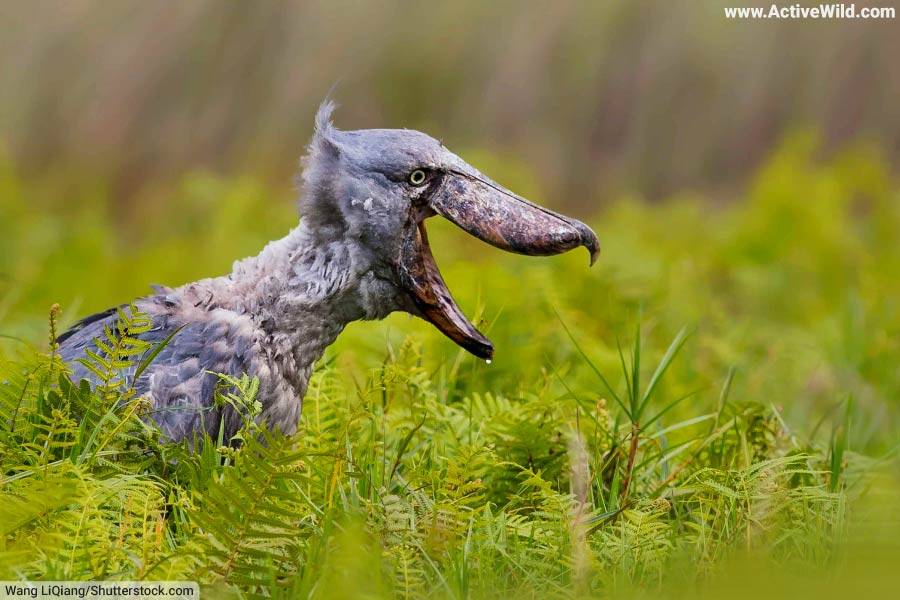
- Scientific Name: Balaeniceps rex
- Family: Balaenicipitidae
- Length: 1.14 meters; 3.75 feet
- Where Found: Tropical east Africa
- IUCN Conservation Status: Vulnerable
The Shoebill is a large bird characterized by a large, shoe-shaped bill. It prefers freshwater swamps and dense marshes where it feeds mainly on fish, using its bill to scoop up prey. It is known for its statue-like stillness while hunting.
Looking at the shoebill, it’s easy to see how birds are the ancestors of dinosaurs.
Discover More with Active Wild
You can see more weird birds on this page: Weird Birds List with Pictures
Discover different types of birds on this page: Types of Birds
Sloth
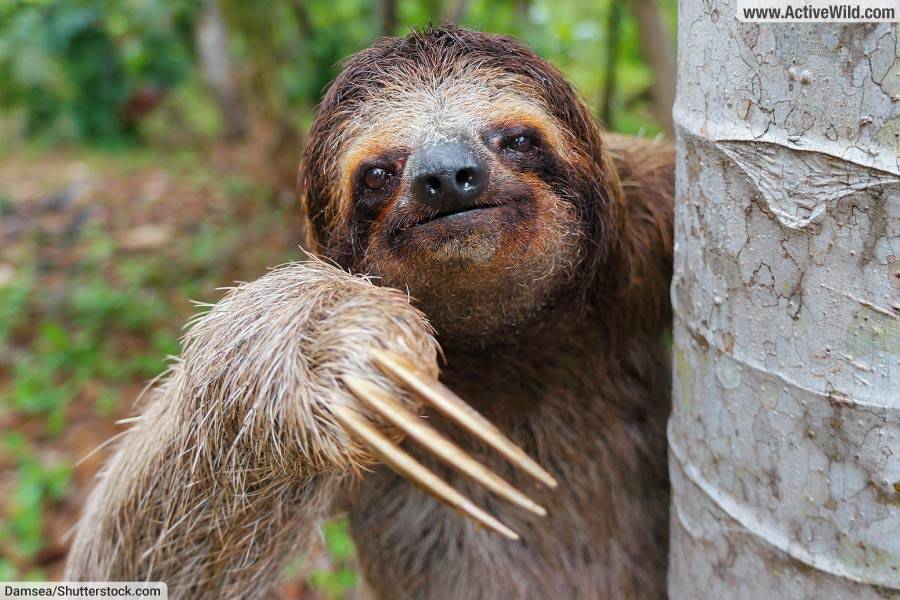
- Scientific Name: Bradypus spp. and Choloepus spp.
- Family: Bradypodidae and Choloepodidae
- Length: 0.5–0.8 meters; 1.6–2.6 feet (varies by species)
- Where Found: Central and South America
- IUCN Conservation Status: Varies by species; ranges from Least Concern to Critically Endangered
Sloths are arboreal mammals known for their slow movements and spending most of their lives hanging upside down in trees. They have a specialized metabolism and diet primarily consisting of leaves. Their fur often houses symbiotic algae, giving them a greenish tint and added camouflage.
The six (or seven – a new species has recently been described) species of sloths are divided between two families: Bradypodidae (three-toed sloths) and Choloepodidae (two-toed sloths).
Discover More with Active Wild
You can see every living sloth species on this page: Types Of Sloths With Pictures And Facts
Snow Leopard
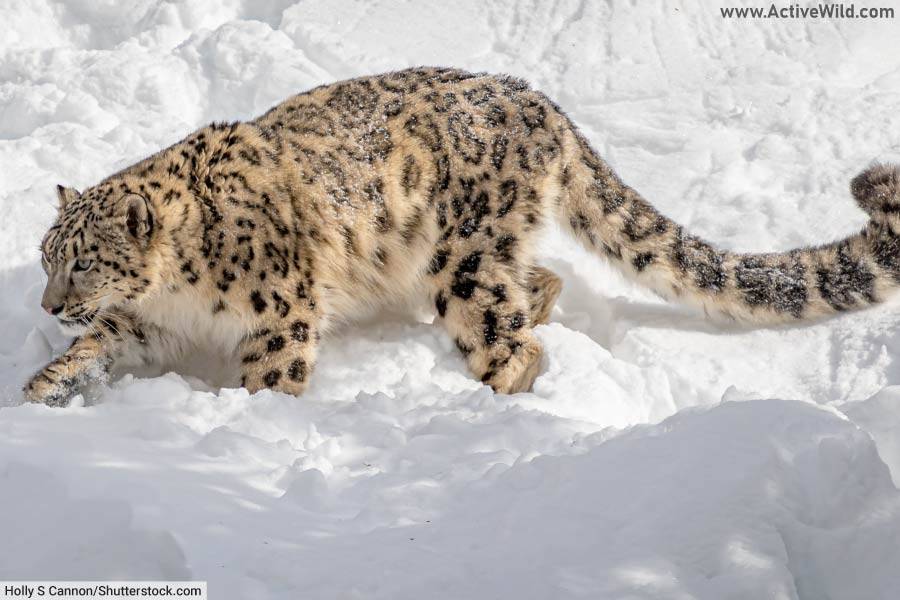
- Scientific Name: Panthera uncia
- Family: Felidae
- Length: 0.9–1.3 meters; 3–4.3 feet
- Where Found: Mountains of Central and South Asia
- IUCN Conservation Status: Vulnerable
The elusive Snow Leopard is well adapted to its harsh, mountainous habitat with a thick coat, wide, fur-covered feet, and long tail for balance. It has a smoky-gray coat patterned with dark rosettes and spots. It primarily preys on blue sheep and Himalayan tahr and is known for its ability to leap up to 9 meters (30 feet).
Discover More with Active Wild
You can find out more about this animal on this page: Snow Leopard Facts
You can see EVERY species of cat on this page: Wild Cats Species List with Pictures and Facts
Superb Lyrebird
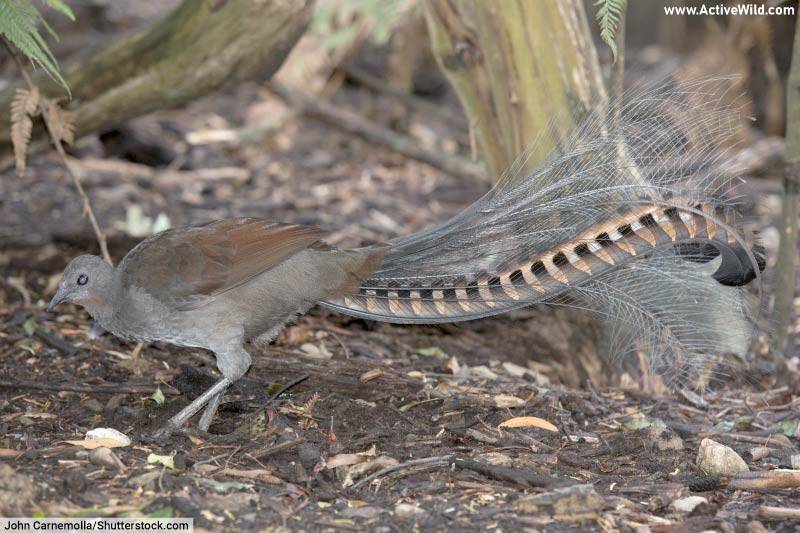
- Scientific Name: Menura novaehollandiae
- Family: Menuridae
- Length: 0.8–1 meter; 2.6–3.3 feet (including tail)
- Where Found: Forests of Southeastern Australia
- IUCN Conservation Status: Least Concern
The Superb Lyrebird is renowned for its extraordinary ability to mimic natural and artificial sounds from its environment. This cool bird can imitate chainsaws, camera shutters, car alarms, and other birds’ songs.
Males are noted for their striking tail feathers, which are displayed beautifully during courtship dances. The elaborate courtship display involves precise movements and vocalizations to attract a mate.
The Superb Lyrebird primarily feeds on ground-dwelling insects, spiders, and other small invertebrates. Despite their ground-dwelling habits, they are also capable of flight. They have strong legs with pectoral claws, adapted to scratching the ground in search of food.
Discover More with Active Wild
Discover different types of birds on this page: Types of Birds
You can see more Australian animals on this page: Australian Animals
Vampire Bat
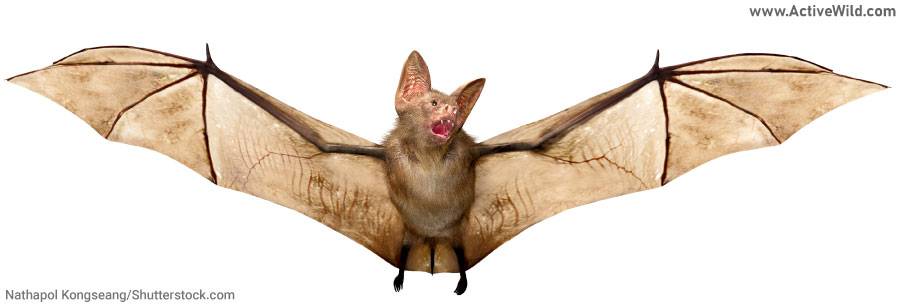
(common name for species in the subfamily Desmodontinae)
- Scientific Name: Desmodus rotundus, Diaemus youngi, Diphylla ecaudata
- Family: Phyllostomidae
- Length: 0.07–0.09 meters; 0.23–0.3 feet (varies by species)
- Where Found: Americas
- IUCN Conservation Status: Least Concern (for Common Vampire Bat, Desmodus rotundus)
Vampire Bats are the only mammals that feed solely on blood. They have heat sensors in their nose to locate the blood vessels of their prey. They make a small incision with their teeth and lap up the blood with their tongues. They have anticoagulant in their saliva to prevent the blood of their victims from clotting.
Discover More with Active Wild
You can find out more about this animal on this page: Vampire Bat Facts
You can see more scary animals on this page: Scary Animals
Wallace’s Flying Frog
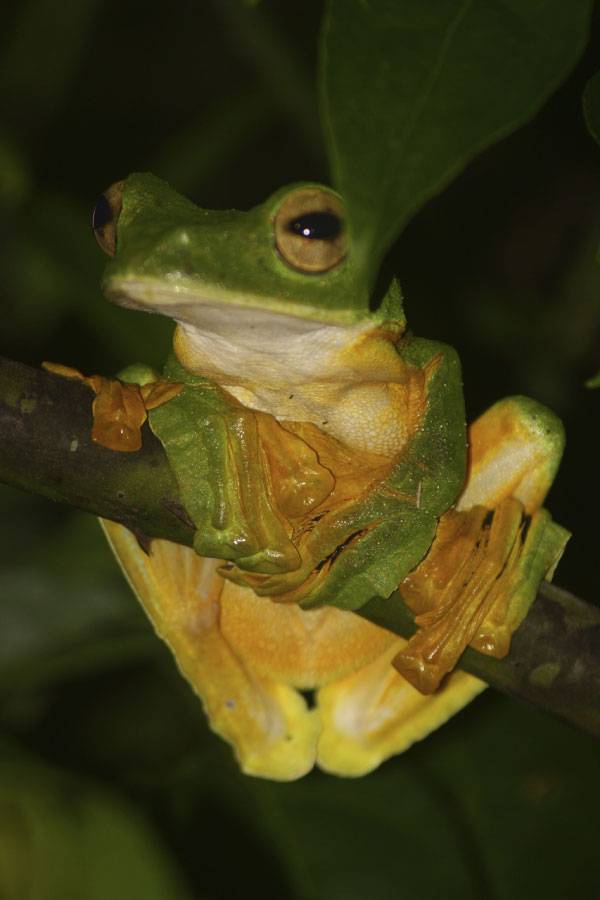
- Scientific Name: Rhacophorus nigropalmatus
- Family: Rhacophoridae
- Length: Approximately 0.1 meters; 4 inches
- Where Found: Malay Peninsula, Borneo, and Sumatra
- IUCN Conservation Status: Least Concern
Wallace’s Flying Frog is named after the naturalist Alfred R. Wallace. Like other flying frogs, it has large webbed feet, allowing it to glide or parachute from tree to tree or to the forest floor. It is primarily arboreal and has a vibrant green color with a white underbelly.
Wallace’s Flying Frog is one of around 380 species of frogs able to glide in this manner.
Discover More with Active Wild
You can find out more about amphibians on this page: Amphibians – The Ultimate Guide
You can discover more amphibians on this page: Amphibians Examples
Wandering Albatross
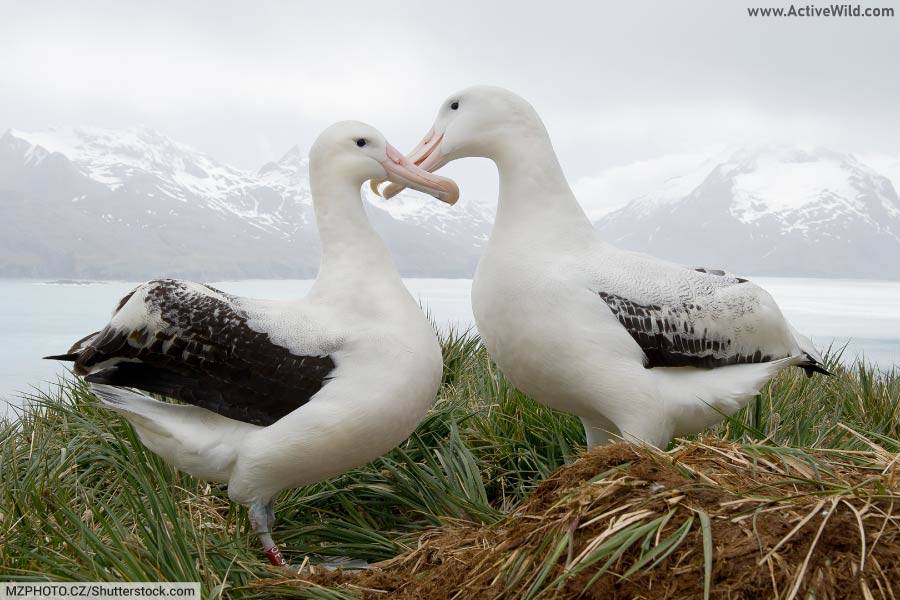
- Scientific Name: Diomedea exulans
- Family: Diomedeidae
- Length: 1.35 meters; 4.4 feet
- Where Found: Southern and North Pacific Oceans
- IUCN Conservation Status: Vulnerable
The Wandering Albatross has the largest wingspan of any living bird, reaching up to 3.5 meters (11 feet). It spends most of its life in flight, traveling thousands of miles over the open ocean, coming ashore only to breed. It feeds primarily on squid, fish, and krill.
Some wandering albatrosses have been recorded flying around the southern part of the world three times in one year – an almost unbelievable distance for a single animal.
Discover More with Active Wild
You can see more Antarctic animals on this page: Antarctic Animals
You can find out more about birds on this page: Birds – The Ultimate Guide
Discover different types of birds on this page: Types of Birds
Whale Shark

- Scientific Name: Rhincodon typus
- Family: Rhincodontidae
- Length: 12.65 meters; 41.5 feet (average)
- Where Found: Tropical Oceans
- IUCN Conservation Status: Endangered
The whale shark is the world’s largest living fish (despite its name, it is a fish, not a whale). This ocean giant is a filter feeder, consuming plankton, small fish, and squid. It has a distinctive pattern of white spots and stripes on its back.
Despite its size, this cool ocean animal remains largely a mystery, with many aspects of its behavior, including its breeding and birthing, remaining unknown.
Discover More with Active Wild
You can find out more about this animal on this page: Whale Shark Facts
Find out more about sharks on this page: Shark Facts
Discover different types of sharks on this page: Types of Sharks
Discover More With Active Wild
Visit our main animals page for links to animal information and a complete guide to the animal kingdom: Animals
The post Cool Animals List With Pictures & Facts: The World’s Coolest Animals appeared first on Active Wild.